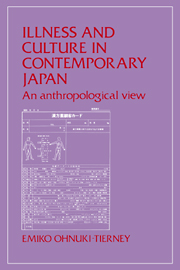Book contents
- Frontmatter
- Contents
- List of illustrations
- Acknowledgments
- 1 Introduction
- Part I Basic concepts and attitudes toward health and illness
- Part II Medical pluralism
- 5 Kanpō: Traditional Japanese medicine of Chinese origin
- 6 Medical roles of Japanese religions: A descriptive overview
- 7 Medical roles of Japanese religions: A historical-symbolic interpretation
- 8 Doctors and outpatients: Biomedicine (I)
- 9 Hospitalization: Biomedicine (II)
- 10 Medical pluralism
- Summary
- References
- Index
9 - Hospitalization: Biomedicine (II)
Published online by Cambridge University Press: 12 January 2010
- Frontmatter
- Contents
- List of illustrations
- Acknowledgments
- 1 Introduction
- Part I Basic concepts and attitudes toward health and illness
- Part II Medical pluralism
- 5 Kanpō: Traditional Japanese medicine of Chinese origin
- 6 Medical roles of Japanese religions: A descriptive overview
- 7 Medical roles of Japanese religions: A historical-symbolic interpretation
- 8 Doctors and outpatients: Biomedicine (I)
- 9 Hospitalization: Biomedicine (II)
- 10 Medical pluralism
- Summary
- References
- Index
Summary
In this chapter I continue to examine the sociocultural aspects of biomedical health care in contemporary Japan by focusing on the process and experience of hospitalization. Many of the following generalizations, and the specific cases that illustrate them, pertain primarily to hospitalization either for the treatment of a physical illness or for an operation. They may therefore not apply to hospitalization for mental illness, to repeated hospitalization for a chronic illness, or to hospitalization at specialized kanpō clinics, only a few of which exist in Japan today. The description is not meant to be exhaustive, and its primary emphasis is perspectives from patients. Therefore, the role of a nurse, for example, is not included in the treatment and the role of a doctor is examined only insofar as it directly affects the patients.
The choice of a particular hospital is based on a number of factors. In the case of a company employee, for example, the firm may have insurance arrangements with certain hospitals. The most important factor in most cases, however, is the choice of a certain doctor who has shown expertise in a type of operation or the treatment of a particular disease. To receive care from such a doctor, some people are willing to choose hospitals a long distance from their homes. To supplement the family doctor's advice, people gather extensive information by word of mouth, although they rely most heavily on the advice of family members. Other things being equal, however, proximity is an important factor because family members continue to take care of patients after they are hospitalized, rather than relegating all this responsibility to the hospital staff.
- Type
- Chapter
- Information
- Illness and Culture in Contemporary JapanAn Anthropological View, pp. 189 - 211Publisher: Cambridge University PressPrint publication year: 1984



